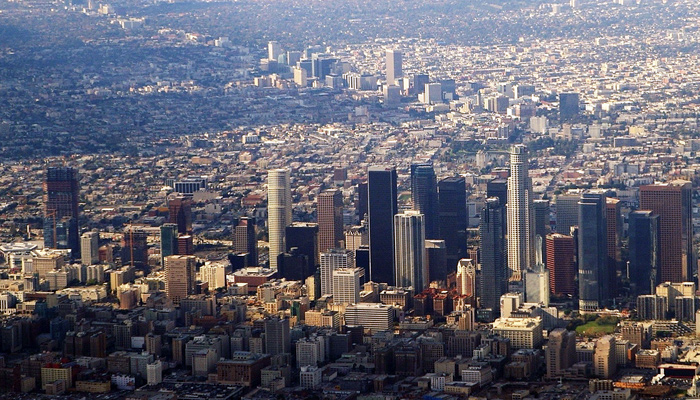Los Angeles

The question in Los Angeles is never what to do, but where to begin. The county is home to many famous attractions in a relatively concentrated space. Your choices include amusement parks, architectural landmarks, art museums and galleries, beaches, parks, hiking and shopping, to name a few. After the sun goes down, you’ll find there’s an abundance of nightlife options.
Los Angeles (i/l?s 'ænd??l?s/ loss-an-j?-l?s; Spanish: [los 'a?xeles]), with a population at the 2010 United States Census of 3,792,621, is the most populous city in the state of California, and the second most populous in the United States, after New York City. It has an area of 468.67 square miles (1,213.8 km2), and is located in Southern California. Often known by its initials L.A., the city is the focal point of the larger Los Angeles-Long Beach-Santa Ana metropolitan statistical area, which contains 12,828,837 people as of 2010, and is one of the most populous metropolitan areas in the world and the second largest in the United States. Los Angeles is also the seat of Los Angeles County, the most populated and one of the most ethnically diverse counties in the United States, while the entire Los Angeles area itself has been recognized as the most diverse of the nation's largest cities. The city's inhabitants are referred to as "Angelenos".
Los Angeles was founded on September 4, 1781, by Spanish governor Felipe de Neve. It became a part of Mexico in 1821 following the Mexican War of Independence. In 1848, at the end of the Mexican–American War, Los Angeles and the rest of California were purchased as part of the Treaty of Guadalupe Hidalgo, thereby becoming part of the United States. Los Angeles was incorporated as a municipality on April 4, 1850, five months before California achieved statehood.
Nicknamed the City of Angels, Los Angeles is a world center of business, international trade, entertainment, culture, media, fashion, science, sports, technology, and education. It is home to renowned institutions covering a broad range of professional and cultural fields and is one of the most substantial economic engines within the United States. Los Angeles has been ranked the third richest city and fifth most powerful and influential city in the world.
The Los Angeles combined statistical area (CSA) has a gross metropolitan product (GMP) of $831 billion (as of 2008), making it the third largest economic center in the world, after the Greater Tokyo and New York metropolitan areas. As the home base of Hollywood, it is also known as the "Entertainment Capital of the World," leading the world in the creation of television and stage production, motion pictures, video games, and recorded music. The importance of the entertainment business to the city has led many celebrities to call Los Angeles and its surrounding suburbs home. Additionally, Los Angeles hosted the 1932 and 1984 Summer Olympics.
Los Angeles has a Subtropical-Mediterranean climate (Köppen climate classification Csb on the coast, Csa inland), and receives just enough annual precipitation to avoid Köppen's BSh (semi-arid climate) classification. Los Angeles has plenty of sunshine throughout the year, with an average of only 35 days with measurable precipitation annually.
The average annual temperature in downtown is 66 °F (19 °C): 75 °F (24 °C) during the day and 57 °F (14 °C) at night. In the coldest month, January, the temperature typically ranges from 59 to 73 °F (15 to 23 °C) during the day and 45 to 55 °F (7 to 13 °C) at night. In the warmest month – August – the temperature typically ranges from 79 to 90 °F (26 to 32 °C) during the day and around 64 °F (18 °C) at night. Temperatures exceed 90 °F (32 °C) on a dozen or so days in the year, from one day a month in April, May, June and November to three days a month in July, August, October and to five days in September. Temperatures are subject to substantial daily swings; in inland areas the difference between the average daily low and the average daily high is over 30 °F (17 °C). The average annual temperature of the sea is 63 °F (17 °C), from 58 °F (14 °C) in January to 68 °F (20 °C) in August. Hours of sunshine total more than 3,000 per year, from an average of 7 hours of sunshine per day in December to an average of 12 in July.
The Los Angeles area is also subject to phenomena typical of a microclimate, causing extreme variations in temperature in close physical proximity to each other. For instance, the average July maximum temperature at the Santa Monica Pier is 75 °F (24 °C) whereas it is 95 °F (35 °C) in Canoga Park. The city, like much of the southern California coast, is subject to a late spring/early summer weather phenomenon called "June Gloom." This involves overcast or foggy skies in the morning which yield to sun by early afternoon.
Downtown Los Angeles averages 15.14 inches (384.6 mm) of precipitation annually, which mainly occurs during the winter and spring (November through April) with generally moderate rain showers, but often as heavy rainfall and thunderstorms during winter storms. The coast gets slightly less rainfall, while the mountains get slightly more. However the San Fernando Valley Region of Los Angeles can get between 16 and 20 inches (410 and 510 mm) of rain per year. Years of average rainfall are rare; the usual pattern is bimodal, with a short string of dry years (perhaps 7–8 inches/180–200 millimetres) followed by one or two wet years that make up the average. Snowfall is extremely rare in the city basin, but the mountains within city limits typically receive snowfall every winter. The greatest snowfall recorded in downtown Los Angeles was 2 inches (5 cm) in 1932. The highest recorded temperature in downtown Los Angeles is 113 °F (45 °C) on September 27, 2010 and the lowest recorded temperature is 24 °F (-4 °C) on December 22, 1944.